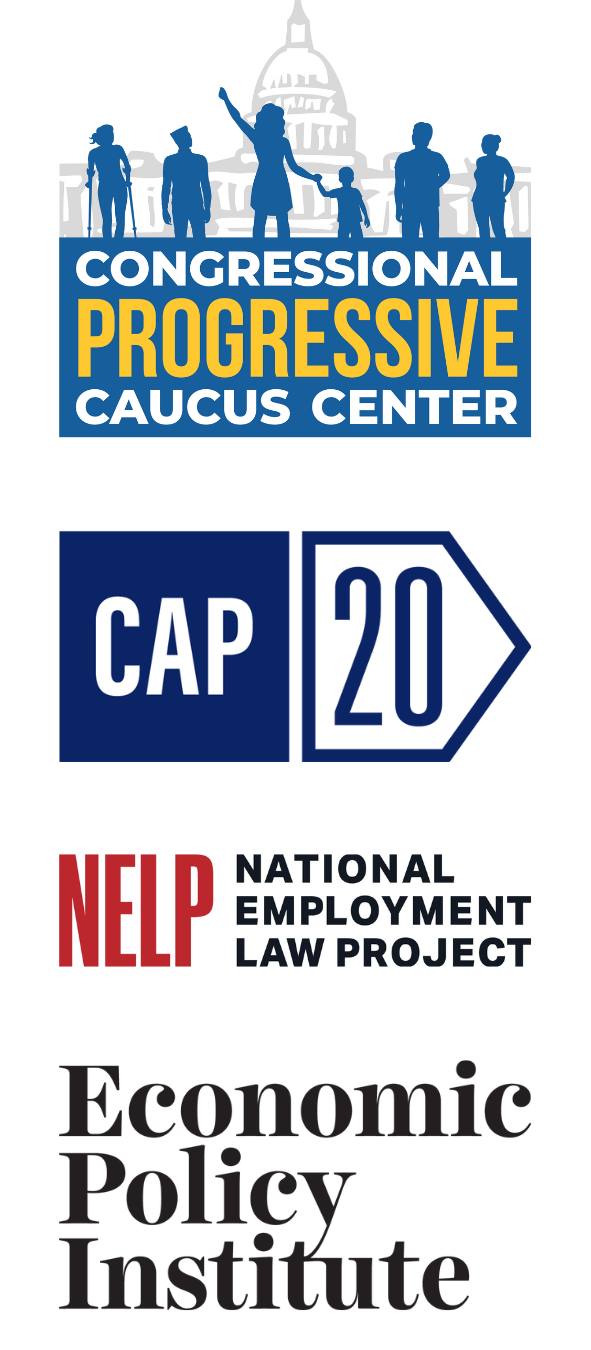The deployment of AI in the workplace has shined a light on long-standing problems: The deployment of AI-powered technologies in the workplace has been associated with an array of worker experiences and outcomes that warrant concern, including discrimination, unsafe working conditions, loss of privacy, and seemingly arbitrary disciplinary action or discharge, among others.

This is a joint project with the Center for American Progress, Congressional Progressive Caucus Center, and National Employment Law Project.
But these outcomes are not inherent to the use of AI. Employers’ use of other technologies and even garden-variety management practices have perpetuated these outcomes for decades. The use of AI has shined a light on the challenges workers with little bargaining power and insufficient on-the-job protections face in our labor market.
Broader solutions are needed to improve worker outcomes in the era of AI: Policymakers should address the negative outcomes experienced by workers today, but they also should look beyond how the use of specific AI systems may degrade job quality and look deeper to the underlying conditions that enable employers to use AI in this manner: the imbalance of power between businesses and their workers.
Workers should have greater protections and a voice in workplace policies: Decades of weakened bargaining power and heavy reliance on employers for life necessities, such as healthcare and retirement, has made it exceedingly difficult for most workers to bargain over how AI technologies are being used in the workplace—let alone opt out of the use of AI-powered management and surveillance at work or walk away from unlawful or poor working conditions.
The objective of worker-centered AI policy: Increase the ability of workers to meaningfully engage their employers in how AI technologies are deployed in the workplace.
To achieve this straightforward objective, policymakers will need to address long-standing imbalances in the labor market; reduce AI-specific barriers to worker voice while banning the most egregious uses of AI; and support workers’ ability to find better jobs.
Pillar one: Expand and expedite pathways to collective bargaining
The impact of AI technologies on workers is not only a function of the current state of technology, but also the institutions and policies that shape how it is implemented in firms across the United States. AI-focused policies must include steps to rebalance workers’ labor market power and ensure most workers can bargain collectively so they can shape how management tools—including AI—are implemented.
- Congress should redouble its effort to pass the Protecting the Right to Organize (PRO) Act and the Public Service Freedom to Negotiate Act. Congress should also consider other incremental steps, such as clarifying workers’ rights to bargain about AI, as well as broader approaches to increasing worker voice, including through sectoral bargaining or tripartite boards.
Pillar two: Reduce AI-specific barriers to worker voice and strengthen employment protections
Opaque management practices and production processes make it exceedingly difficult for workers to express their voice about how their workplace is organized and run—AI systems exacerbate this problem.
- Policymakers should increase transparency around firm-level use of AI technologies by requiring employers to disclose their use of electronic monitoring, surveillance, and automated decision-making systems, as well as employment related-data and decisions produced by such systems, in a manner that is actionable for workers and their representatives.
Many labor and employment laws today already prohibit many things that workers who are using or subject to AI are experiencing. Businesses’ use of AI, in some cases, is skirting workers’ existing rights and facilitating the shifting of work into more underpaid and precarious structures, like gig work. In other cases, existing law is not sufficient for protecting workers from the worst abuses, whether they stem from AI decision-making and surveillance technologies or older forms of exploitation.
- Congress should adequately fund worker protection agencies—such as the Equal Employment Opportunity Commission, the National Labor Relations Board, and the Department of Labor—which have all issued various forms of guidance clarifying the applicability of relevant laws to the use of AI technologies.
- Policymakers and federal agencies should more fully leverage existing authorities to address problematic workplace outcomes that have been exacerbated by the use of AI technologies by issuing new guidance and regulatory standards to address issues related to discrimination, unsafe working conditions, and obscuring the employment relationship.
- Congress should ban the use of AI-assisted decision-making processes for firing and disciplinary actions that do not include human involvement, and should require employers using any AI-assisted systems for such decisions to establish due process procedures administered by human supervisors—including meaningful opportunities to correct faulty data and adequate warning before termination.
- Congress should ban invasive kinds of workplace surveillance, including facial and emotional recognition, monitoring a worker’s activities related to a labor organization, and predicting the behavior of a worker or collecting health information unrelated to job duties.
- Congress should regulate employer use of automated decision-making systems to prevent dangerous risks to the safety, security, or health of workers, clients, or the public that may result from automated decisions related to staffing.
Pillar three: Increase workers’ ability to leave employers who create exploitative conditions with AI (or other technologies and practices) and ease job transitions
One of the most effective solutions to easing the impact of any AI-related job transition for workers is strengthening the social insurance system. Similarly, one of the strongest moves workers can play when they are in a job with poor working conditions—because of the use of AI or other management practices—is finding another job. A strong social insurance system and low unemployment will increase the ability of workers to leave bad jobs.
- Congress should strengthen unemployment insurance protections and take steps to reduce the cost of health care and increase access to retirement security; policymakers should extend and improve workforce development programs.
- Policymakers should support macroeconomic policies that achieve sustained periods of very low unemployment and quickly restore the labor market to health after recessionary shocks, including considering policies to guarantee jobs are available.
